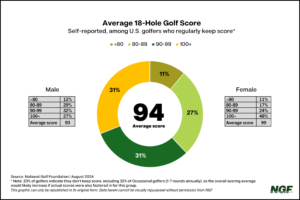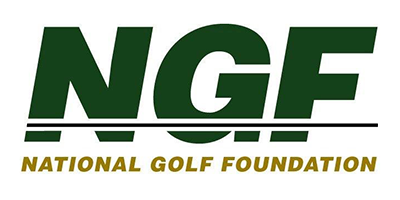JUPITER, Florida — What does the average golfer shoot during a round of golf? It seems like a straightforward question, but there’s some gray area.
NGF participation research finds more than three-quarters of U.S. golfers (77%) keep score on a regular basis.
The approximately 20 million golfers who do keep score tend to shoot in the mid-90s, with an average of 94. That hasn’t changed substantially in recent years.
There are, however, some important caveats to golfer-reported scoring, all of which likely skew the actual average upwards. Consider:
- Those players who do keep score are generally more skilled
- Almost 1/3 of Occasional golfers (1-7 rounds annually) don’t keep score and are likely less proficient players
- More than half of golfers suggest they take scoring liberties (mulligans, breakfast balls, gimmes, no OB, etc.)
 Remember, anything is possible with 5-foot gimmes and an eraser.
Remember, anything is possible with 5-foot gimmes and an eraser.
There was some natural skepticism when our golfer-reported data suggested almost 1-in-10 golfers regularly shoot under 80 during an 18-hole round.
But we compared notes with the USGA and the findings are directionally similar, with almost 11% of male golfers and about 2% of female golfers having a handicap index of 4.9 or less.
More than 3.2 million golfers in the U.S. have an active, official handicap index, a total that’s risen 23% since the unified World Handicap System (WHS) was launched by the USGA and R&A in 2020.
You may have seen stories citing NGF research from decades ago that suggests the average 18-hole score for a round of golf is around 100. That was a smaller sample size and the way the survey question was asked was less specific.
Weighting the above golfer-reported average to account for scoring liberties as well as those players who don’t keep score – many of whom might reach their “max” on many holes – moves the probable “average golfer” score closer to triple figures than the mid-90s.
That said, are golfers getting better?
Our research indicates that, historically, about 17% of U.S. golfers take formal instruction, with many more likely taking a DIY approach by gleaning swing tips from videos on YouTube or social media. Despite the room for growth, professional golf instruction is more than a $1 billion industry, as playing better golf typically correlates to greater enjoyment.
Yes, there are 6 million+ golfers uninterested in keeping score. For many of them, golf is less about competition and scoring, and more about camaraderie, spending time with friends and family, getting outside, or exercising their mind and body.
For the majority of golfers, however, the quest for improvement – and the lower scores that hopefully follow – is a never-ending one.
The USGA handicap index (and keeping score regularly) is a good measurement, as it allows for an equitable adjustment based on a player’s ability. To get an official handicap index, golfers can register at a nearby course, or sign up for their local Allied Golf Association (AGA) through the USGA’s website.


